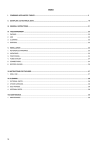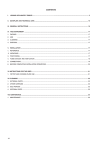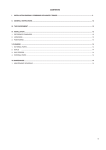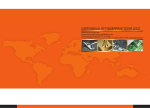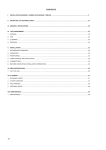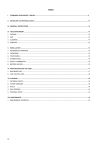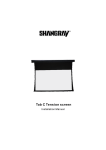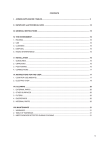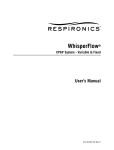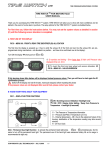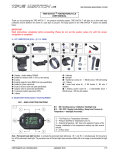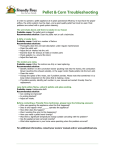Download User Manual - SharePoint
Transcript
INDEX I. COMBINING APPLIANCES / TABLES ..................................................................................................................................... 2 II. GENERAL INSTRUCTIONS ..................................................................................................................................................... 8 III. THE ENVIRONMENT ................................................................................................................................................................ 9 IV. INSTALLATION ......................................................................................................................................................................... 9 1. REFERENCE STANDARDS ...................................................................................................................................................... 9 2. UNPACKING .............................................................................................................................................................................. 9 3. POSITIONING ............................................................................................................................................................................ 9 V. CLEANING ............................................................................................................................................................................... 10 1. EXTERNAL PARTS .................................................................................................................................................................. 10 2. IDLE PERIODS ........................................................................................................................................................................ 10 7 III. GENERAL INSTRUCTIONS • Carefully read the instruction handbook before using the appliance. • After installation keep the instruction handbook for future consultation. • FIRE HAZARD - Keep the area around the appliance clear and free from combustible materials. Do not keep flammable materials in the vicinity of the appliance. • Install the appliance in a well-ventilated place to avoid the creation of dangerous mixtures of unburnt gases in the room. • Air recirculation must take in account the air necessary for combustion, 2 m³/h/kW gas power, and also the “well-being” of those working in the kitchen. Inadequate ventilation causes asphyxia. Do not obstruct the ventilation system of the place where the appliance is installed. Do not obstruct the vents or ducts of this or other appliances. sos • Place emergency telephone numbers in a visible position. • Installation, maintenance and conversion to another type of gas must only be carried out by qualified personnel authorised by the manufacturer. For assistance, contact an authorised technical centre. Demand original spare parts. • This equipment is designed for cooking food. It is intended for industrial use. Any other use is to be considered improper. • This appliance is not intended for use by people (including children) with limited physical, sensory or mental abilities or without experience and knowledge of it, unless they are supervised or instructed in its use by a person responsible for their safety. • The appliance must be used by trained personnel. Do not leave the appliance unattended when operating. • Turn the appliance off in case of fault or poor operation. • Do not use products (even if diluted) containing chlorine (sodium hypochlorite, hydrochloric or muriatic acid, etc.) to clean the appliance or the floor under it. Do not use metal tools to clean steel parts (wire brushes or Scotch Brite type scouring pads). • Do not allow oil or grease to come into contact with plastic parts. • Do not allow dirt, fat, food or other residuals to form deposits on the appliance. • Do not clean the appliance with direct jets of water. • The symbol L given on the product indicates that it should not be considered domestic waste, but must be correctly disposed of in order to prevent any negative consequences for the environment and the health of persons. For further information regarding the recycling of this product, contact the product agent or local dealer, the after-sales service or the local body responsible for waste disposal. • • • • • Warnings: Do not store or use gasoline or other flammable vapours, liquids or items in the vicinity of this or any other appliance. Do not spray aerosols in the vicinity of this appliance while it is in operation. Never check for leaks with an open flame The appliance is not suitable for a marine environment. Failure to observe the above can compromise the safety of the appliance. Failure . to observe the above invalidates the warranty. 8 III. THE ENVIRONMENT IV. INSTALLATION 1.PACKING • Packing materials are environment friendly and can be stored without risk, or burned in a special waste incineration plant. Recyclable plastic components are marked with: PE Polyethylene: outer wrapping, instruction booklet bag, gas nozzle bag. Polypropylene: roof packing panels, straps. PP Polystyrene foam: corner protectors. PS • Carefully read the installation and maintenance procedures given in this instruction manual before installing the appliance. • Installation, maintenance and conversion to another type of gas must only be carried out by qualified personnel authorised by the manufacturer. Failure to observe the correct appliance installation, conversion and modification procedures can cause damage to the appliance, danger to persons and invalidates the Manufacturer’s warranty. 1. REFERENCE STANDARDS • Install the appliance in accordance with the safety regulations and local laws of the country where used. 2.USE Our appliances offer high performance and efficiency. To reduce consumption of electricity, water or gas, do not use the appliance empty or in conditions that compromise optimal efficiency (e.g. with doors or lids open, etc.); the appliance is used in a well-ventilated place to avoid the creation of dangerous mixtures of unburnt gases in the room. Whenever possible, pre-heat only before use. 3.CLEANING In order to reduce the emission of pollutants into the environment, clean the appliance (externally and when necessary internally) with products that are more than 90% biodegradable (for further information, see chap. V “CLEANING”). 4.DISPOSAL Do not disperse in the environment. Our appliances are manufactured using more than 90% (in weight) recyclable metals (stainless steel, iron, aluminium, galvanised sheet, copper, etc.). Make the appliance unusable by removing the power cable and any compartment or cavity closing mechanisms (when present) in order to avoid the risk of someone becoming closed inside. 2. UNPACKING IMPORTANT! Immediately check for any damage caused during transport. • The forwarder is responsible for the goods during transport and delivery. • Inspect the packing before and after unloading. • Make a complaint to the forwarder in case of visible or hidden damage, reporting any damage or shortages on the dispatch note on delivery. • The driver must sign the dispatch note: the forwarder can reject the claim if the dispatch note is not signed (the forwarder can provide the necessary form). • Unpack, taking care not to damage the equipment. Wear protective gloves. • Carefully remove the protective film from metal surfaces and clean any traces of glue with a suitable solvent. • For hidden damage or shortages becoming apparent only after unpacking, request the forwarder for inspection of the goods within and not later than 15 days of delivery. • Keep all the documentation contained in the packing. 3. POSITIONING • Handle the equipment with care in order to avoid damage or danger to persons. Use a pallet for handling and positioning. • The installation diagram given in this instruction manual gives the appliance dimensions and the position of connections (gas, electricity, water). Check that they are available and ready for making all the necessary connections. • The appliance can be installed separately or combined with other appliances of the same range. • The appliances are not designed for built-in installation. Leave at least 10 cm between the appliance and side or rear walls. • Suitably insulate surfaces that are at distances less than those recommended. • Maintain an adequate distance between the appliance and any combustible walls. Do not store or use flammable materials and liquids near the appliance. • Leave an adequate space between the appliance and any side walls in order to enable subsequent servicing or maintenance operations. • Check and if necessary level the appliance after positioning. Incorrect levelling can cause appliance malfunctioning. 9 3.1. COMBINING APPLIANCES • (Fig.1A) Undo the 4 fixing screws and remove the control panels of the appliances. • (Fig.1B) Remove the fixing screw nearest the control panel, from each side to be joined. • (Fig.1D) Bring the appliances together and level them by turning the feet until the tops match. • (Fig.1C) Turn one of the two plates inside the appliances 180º. • (Fig.1E) From inside the control panel of the same appliance, join them at the front side, screwing one TE M5x40 screw (supplied) on the opposite insert. 3.2. FLOOR FIXING To avoid accidental tipping of built-in half-module appliances installed separately, fix them to the floor carefully following the instructions enclosed with the corresponding accessory (F206136). 3.3 INSTALLATION ON BRIDGE, CANTILEVER FRAME OR CEMENT PLINTH Carefully follow the instructions enclosed with the corresponding accessory. 3.4 ASSEMBLY AND JOINING OF COUNTER TOP APPLIANCES ON BASE (fig. 2A, 2B, 2C) • Position the counter top appliance “T” on the support base “C”. • Fix the counter top appliance to the base by screwing the screws in the special seats • For half-module and individually installed appliances, securing to the floor is advisable in order to guarantee better stability (see Accessory). 3.5 SEALING GAPS BETWEEN APPLIANCES Follow the instructions supplied with the optional sealing paste pack. 10 V CLEANING 1. EXTERNAL PARTS SATIN-FINISH STEEL SURFACES (daily) • Clean all steel surfaces: dirt is easily removed when just formed. • Remove dirt, fat and food deposits from steel surfaces when cool, using soapy water, with or without detergent, applied with a cloth or sponge. Dry the surfaces thoroughly after cleaning. • For stubborn dirt, grease or food residuals, wipe the cloth/ sponge with the grain of the satin finish and rinse often: rubbing in a circular motion, combined with the particles of dirt deposited on the cloth/sponge, could damage the steel’s satin finish. • Iron objects could ruin or damage the steel: damaged surfaces become dirty more easily and are more liable to corrode. • Have the satin finish repaired if necessary. SURFACES BLACKENED BY HEAT (when necessary) Exposure to high temperatures can cause the formation of dark marks. These do not constitute damage and can be removed by following the instructions in the previous paragraph. 2. IDLE PERIODS If the appliance is not going to be used for some time, rub all stainless-steel surfaces vigorously with a cloth moistened with vaseline oil in order to form a protective film. Periodically air the premises.




